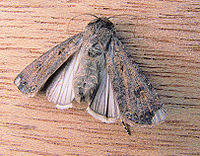Description[edit]
The dark sword-grass has pale brown forewings with dark brown and black markings and translucent hindwings, greyish white with brown venation. The hindwings have a thin dark line along the margins of the hindwings.[4]
The moth gets its specific name from black markings on the forewings shaped like a Y and resembling the Greek letter 'ipsilon'.
The moth has a wingspan of from four to five and a half centimetres.[1]
Range[edit]
The moth is found in many regions of the world. It is absent from some tropical regions and colder areas and is more widespread in the northern than the southern hemisphere. It reinvades temperate areas each year having overwintered in warmer or subtropical regions.[2]
The caterpillar of the dark sword-grass is smooth and ranges from purplish to brown in colour and is patterned with grey lines and spots.[1]
Host plants[edit]
The adults feed on nectar from flowers. Weeds are often preferred to crops by the larvae. Some favoured species include bluegrass, curled dock, lambsquarters, yellow rocket and redroot pigweed. Among crop plants, the larvae favour most vegetable plants, alfalfa, clover, cotton, rice, sorghum, strawberry, sugarbeet, tobacco and sometimes grains and grasses.[2]
Damage[edit]
Each larva can consume over 400 square centimetres of foliage during its development. They feed above ground until about the fourth instar. After that they do considerable damage to crops by severing young plants at ground level. In the midwestern USA the black cutworm is considered to be a serious pest of corn which is very susceptible at the one-leaf stage but by the 4 or 5-leaf stage it is relatively unaffected. Damage to the underground parts of plants can also be harmful.[2] Other crops where serious damage occurs include cotton, maize, tobacco, sunflower, tomatoes, sugar beet and potato.[5]



No hay comentarios:
Publicar un comentario